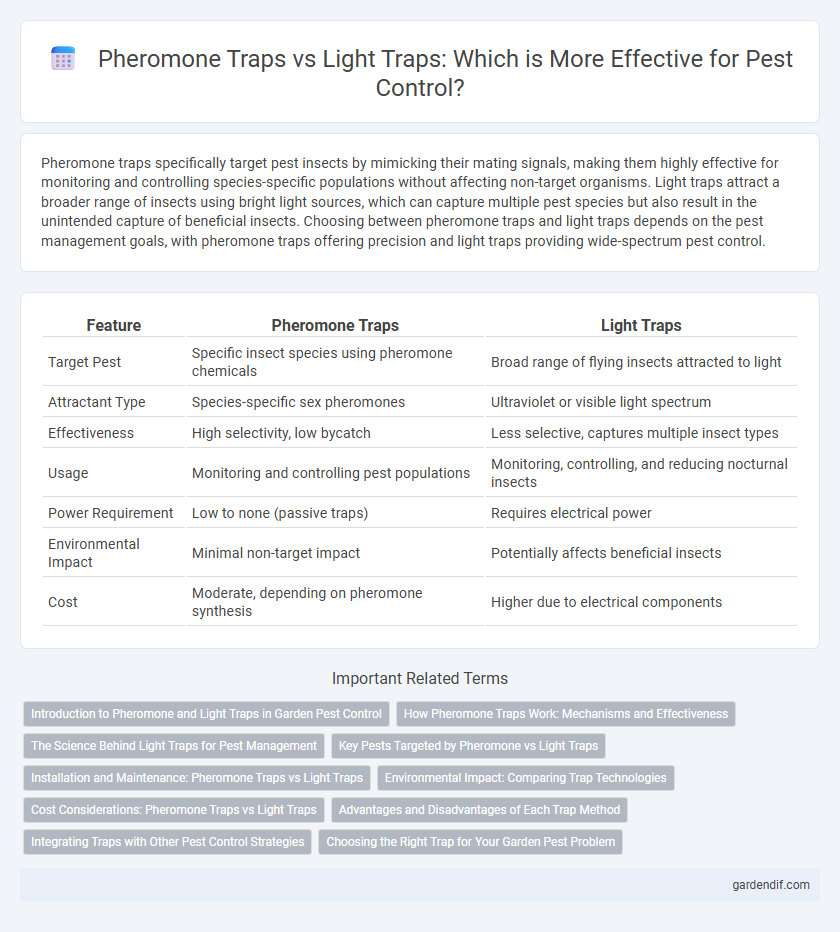
Pheromone traps vs Light traps Illustration
Pheromone traps specifically target pest insects by mimicking their mating signals, making them highly effective for monitoring and controlling species-specific populations without affecting non-target organisms. Light traps attract a broader range of insects using bright light sources, which can capture multiple pest species but also result in the unintended capture of beneficial insects. Choosing between pheromone traps and light traps depends on the pest management goals, with pheromone traps offering precision and light traps providing wide-spectrum pest control.
Table of Comparison
| Feature | Pheromone Traps | Light Traps |
|---|---|---|
| Target Pest | Specific insect species using pheromone chemicals | Broad range of flying insects attracted to light |
| Attractant Type | Species-specific sex pheromones | Ultraviolet or visible light spectrum |
| Effectiveness | High selectivity, low bycatch | Less selective, captures multiple insect types |
| Usage | Monitoring and controlling pest populations | Monitoring, controlling, and reducing nocturnal insects |
| Power Requirement | Low to none (passive traps) | Requires electrical power |
| Environmental Impact | Minimal non-target impact | Potentially affects beneficial insects |
| Cost | Moderate, depending on pheromone synthesis | Higher due to electrical components |
Introduction to Pheromone and Light Traps in Garden Pest Control
Pheromone traps utilize species-specific chemical signals to attract and capture targeted pests, enabling precise monitoring and reduction of harmful insect populations in gardens. Light traps employ ultraviolet or visible light to lure various nocturnal pests, providing a broad-spectrum control method that is effective against multiple insect types. Both traps serve as environmentally friendly alternatives to chemical pesticides, enhancing integrated pest management strategies by minimizing collateral damage to beneficial organisms.
How Pheromone Traps Work: Mechanisms and Effectiveness
Pheromone traps operate by releasing synthetic insect sex pheromones that mimic natural chemical signals, attracting specific pest species such as moths, beetles, or aphids. These traps effectively monitor pest populations by luring targeted insects into a confined area where they become trapped, reducing mating opportunities and enabling early detection of infestations. Studies demonstrate that pheromone traps offer high specificity and sensitivity, making them essential tools in integrated pest management programs for timely and environmentally friendly pest control.
The Science Behind Light Traps for Pest Management
Light traps for pest management utilize specific wavelengths of light to attract nocturnal insects, exploiting their natural phototactic behavior. These traps often emit ultraviolet or blue light, which insects mistakenly associate with natural light sources, leading them to the trap for capture or extermination. The effectiveness of light traps hinges on understanding insect vision and behavior, optimizing light intensity and spectrum to target specific pest species while minimizing impacts on non-target organisms.
Key Pests Targeted by Pheromone vs Light Traps
Pheromone traps primarily target specific insect pests such as moths, beetles, and weevils by releasing synthetic sex attractants that lure male insects for monitoring or control. Light traps attract a broader range of flying pests including moths, beetles, and flies by using ultraviolet or visible light to draw them in. The species specificity of pheromone traps makes them more effective for targeted pest management, while light traps serve as versatile tools for monitoring diverse nocturnal pest populations.
Installation and Maintenance: Pheromone Traps vs Light Traps
Pheromone traps require precise placement to effectively attract target pests by mimicking their natural mating signals, usually needing minimal maintenance apart from regular lure replacement. Light traps demand strategic installation in dark or shaded areas to maximize insect attraction and often require frequent cleaning and bulb replacements to maintain optimal performance. Both trap types benefit from periodic monitoring, but pheromone traps generally involve less upkeep compared to the more maintenance-intensive light traps.
Environmental Impact: Comparing Trap Technologies
Pheromone traps target specific insect species using chemical attractants, minimizing non-target captures and reducing ecological disruption. Light traps attract a broad range of insects, often leading to higher bycatch and potential harm to beneficial insect populations, including pollinators. The selective nature of pheromone traps offers a more environmentally sustainable pest management option compared to the broader impact of light traps.
Cost Considerations: Pheromone Traps vs Light Traps
Pheromone traps generally present a lower upfront cost and target specific pest species, reducing the need for frequent replacements and chemical controls. Light traps, while often more expensive initially due to electrical components and bulbs, may attract a broader range of insects but incur higher energy and maintenance expenses. Cost-effectiveness depends on pest management goals, target species specificity, and operational budget constraints.
Advantages and Disadvantages of Each Trap Method
Pheromone traps offer high specificity by attracting only targeted pest species, reducing non-target captures and chemical use, but they can be less effective in areas with low pest populations. Light traps attract a broader range of nocturnal insects, providing extensive monitoring coverage but often capturing beneficial species unintentionally, leading to ecological imbalance. Each trap method's effectiveness depends on pest behavior and monitoring goals, necessitating careful selection to optimize pest management strategies.
Integrating Traps with Other Pest Control Strategies
Integrating pheromone traps with other pest control strategies enhances monitoring accuracy and reduces pest populations more effectively than using light traps alone. Pheromone traps target specific insect species by mimicking mating signals, allowing for precise population assessment and timely intervention, while light traps attract a broad range of nocturnal insects but may cause non-target species mortality. Combining pheromone traps with biological control agents and selective insecticides creates a sustainable, integrated pest management (IPM) approach that minimizes environmental impact and improves overall pest suppression.
Choosing the Right Trap for Your Garden Pest Problem
Pheromone traps target specific pest species by mimicking their mating signals, making them highly effective for monitoring and controlling pests like moths and beetles in your garden. Light traps attract a broad range of nocturnal insects but can sometimes capture beneficial species, which may disrupt ecosystem balance. Selecting the right trap depends on identifying the pest species present and the level of precision needed to minimize collateral effects on non-target insects.
Pheromone traps vs Light traps Infographic

 gardendif.com
gardendif.com